![]()
![]()
![]()
Use LEFT and RIGHT arrow keys to navigate between flashcards;
Use UP and DOWN arrow keys to flip the card;
H to show hint;
A reads text to speech;
22 Cards in this Set
- Front
- Back
|
What are three functions of blood? |
1. Transporting oxygen, carbon dioxide, nutrients, hormones, and wastes by binding to them 2. Providing protection against disease, injury, and infection by blood clotting to prevent excessive loss of blood and phagocytic white blood cells and proteins such as antibodies 3. Helping maintain homeostasis of body fluids by regulating pH through use of buffers |
|
|
Hemopoiesis |
Process of developing formed elements |
|
|
Where does hemopoiesis occur in the embryo vs. the fetus vs. after birth? |
Embryo: yolk sac Fetus: liver, spleen, thymus, lymph nodes After birth: red bone marrow |
|
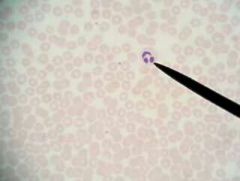
What is this type of blood cell and what is its size and function? |
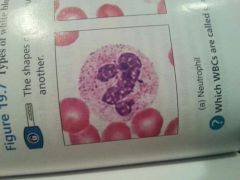
Neutrophil (identified by 2-7 connected lobes, larger than RBC) Size : 10-12 micrometers Function: phagocytosis of bacteria with lysozyme, defensins, and strong antioxidants |
|
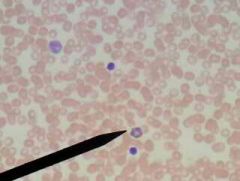
Identify the blood cell, its size, and function. |
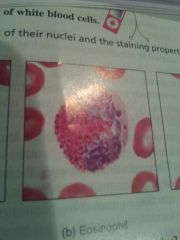
Eosinophil (granules in cytoplasm stain red, nucleus bilobed) Size: 10-12 micrometres Function: combat effects of histamine in allergic reactions, phagocytize antigen-antibody complexes, and destroy parasitic worms |
|

Identify the blood cell, its size, and function. |
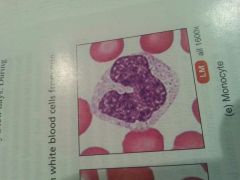
Monocyte (horseshoe shaped nucleus) Size: 12-20 micrometres Function: phagocytize cellular debris and microbes after a viral or fungal infection (after transforming into wandering or fixed macrophages) |
|
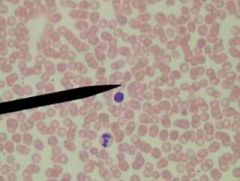
Identify the red blood cell, its size, and function. |
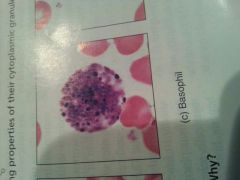
Basophil (nucleus cant be distinguished from granules) Size: 8-10 micrometres Function: liberate heparin, histamine, and serotonin in allergic reactions which intensify inflammatory response |
|

Identify the red blood cell, its size, and function. Include B and T cells and NKC. |

Lymphocytes (large round nucleus almost fills cell but some cytoplasm visible) Size: small ones are 6-9 micrometres; large ones are 10-14 micrometres Function: mediate immune responses including antigen-antibody reactions. B-cells develop into plasma cells (secrete antibodies). T-cells attack invading viruses, cancer cells, and transplanted tissue. NKC attack infectious microbes and certain tumor cells. |
|
|
erythrocytes |
small, biconcave, anucleate cells containing hemoglobin molecules |
|
|
hemoglobin a) description b) function |
a) a protein with four iron atoms b) reversibly bind oxygen and carbon dioxide molecules |
|
|
platelets - description and function |
a) Fragments of megakaryocytes enclosed in a plasma membrane. b) - form the platelet plug to stop blood loss from ruptured blood vessels; - secrete chemicals from their granules that promote blood clotting |
|
|
leukocytes |
a) have a nucleus b)- can travel to all parts of the body in the blood and lymph; - can move out of blood vessels by emigration to get to the site of pathogen invasion or inflammation |
|
|
hematocrit - what is it and what is it used for? |
=measure of the percent of red blood cells in a whole blood sample - it's a part of a Complete Blood Count (CBC) and can be used in combination with other tests for: a) the diagnosis of anemia and polycythemia b) to evaluate dehydration and recovery c) to evaluate the effectiveness of blood transfusions |
|
|
Describe the contents of a hematocrit and how to interpret the findings. |
- heaviest cells (RBC) are forced to the bottom of the tube - the fluid (plasma) rises to the top - the white blood cells (WBCs) and platelets can be seen at the top of the RBCs in a thin layer, the buffy coat - the height of the RBCs in the column is measured as a percent of the total height of the column of blood |
|
|
Describe the procedure of a hematocrit |
1. centrifuge a small sample of blood in a tube 2. bottom of blood placed at "0" mark of a card, and slide along the card until the top of the blood sample reaches "100" 3. the line closest to the top of the RBCs can be read to find the packed cell volume % |
|
|
List two conditions which can result in an increased (higher than normal) hematocrit |
dehydration (due to burns, diarrhea, concentrating the blood) polycythemia (bone marrow or lung function problems) |
|
|
List two conditions which can result in decreased (lower than normal) hematocrit |
anemia hemorrhage |
|
|
What is blood typing based on? |
the presence or absence of certain genetically determined antigens (agglutinogens) on the surface of the erythrocytes - the surface antigens on your RBCs are recognized by your immune system as being "self" and as a result, they are not attacked |
|
|
What a re some examples of "foreign" antigens that will be attacked? |
pollen, dust particles, and cells whose membranes contain foreign surface markers |
|
|
What do antibodies do? |
after appearing within a few months of birth, they react to specific "foreign" antigens to inhibit or destroy them - they are not produced against own cells, except in some autoimmune diseases |
|
|
What is the source of antibodies in the antibody-mediated immune response? |
plasma cells |
|
|
What does the Finger Pulse Oximeter measure and what is it designed to determine? |
blood oxygen saturation and pulse rate determines the arterial oxygen saturation of functional hemoglobin, expressed as a percentage. |

